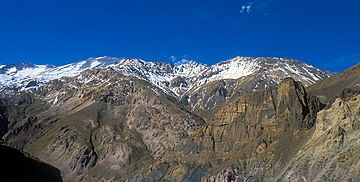San José (volcano) facts for kids
Quick facts for kids Volcán San José |
|
|---|---|

The San Jose (right) and La Engorda (left) volcanoes seen from across Baños Morales, high up in the Cajón del Maipo canyon.
|
|
| Highest point | |
| Elevation | 5,856 m (19,213 ft) |
| Geography | |
| Location | Argentina / Chile |
| Parent range | Principal Cordillera, Andes |
| Geology | |
| Mountain type | Stratovolcano |
| Last eruption | 1960 |
San José Volcano is a large, cone-shaped volcano. It is known as a stratovolcano because of its steep sides and explosive eruptions. This volcano is located about 90 kilometers (56 miles) from Santiago in Chile. It sits right on the border between Chile and Argentina.
San José Volcano is part of a much bigger group of volcanoes. This group stretches about 10 kilometers (6 miles) long and 5 kilometers (3 miles) wide. Other volcanoes in this area include La Engorda, Espiritu Santo, Plantat, and Marmolejo. San José Volcano is at the southern end of this impressive volcanic chain.
Contents
What is a Stratovolcano?
A stratovolcano is a type of volcano that looks like a tall cone. It is built up over time by many layers of hardened lava, ash, and rocks. These volcanoes often have steep slopes and a crater at the top. They are known for their powerful and sometimes explosive eruptions.
When a stratovolcano erupts, it can send ash high into the sky. It can also produce fast-moving flows of lava and hot gas. San José Volcano is a great example of this kind of powerful natural formation.
Where is San José Volcano Located?
San José Volcano is found in the Andes mountain range. This huge mountain chain runs along the western side of South America. The volcano is specifically located at the end of the Cajón del Maipo. This is a beautiful canyon area in Chile.
The Cajón del Maipo is famous for its stunning mountain views. It has rivers, hot springs, and many outdoor activities. The volcano stands tall as a landmark in this rugged and scenic region. Its location on the border makes it a shared natural wonder between Chile and Argentina.
When Did San José Volcano Last Erupt?
Volcanoes can be active, dormant, or extinct. An active volcano means it could erupt again. San José Volcano is considered an active volcano. Its last known eruption happened in 1960.
When a volcano erupts, it releases molten rock, ash, and gases from deep inside the Earth. The 1960 eruption was a significant event for the volcano. Scientists continue to monitor active volcanoes like San José. This helps them understand and predict future activity.
Exploring the Area Around the Volcano
The area around San José Volcano is popular for outdoor adventures. The Cajón del Maipo offers many chances to explore nature. People can go hiking, climbing, and enjoy the fresh mountain air. The views of the Andes mountains are truly amazing.
Even though the volcano is active, many people visit the region safely. They come to see the beautiful landscapes and experience the power of nature. The volcano reminds us of the incredible forces shaping our planet.
See also
 In Spanish: Volcán San José para niños
In Spanish: Volcán San José para niños
- List of volcanoes in Argentina
- List of volcanoes in Chile

